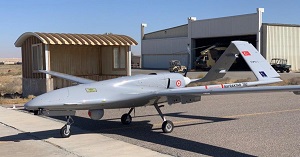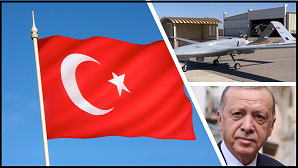[Editor’s Note: Army Mad Scientist is pleased to present our latest episode of The Convergence podcast, featuring Karen Kaya — Senior Turkey/Middle East Analyst for the Foreign Military Studies Office (FMSO), within the TRADOC G-2 — discussing the Bayraktar TB-2 Unmanned Aerial Vehicle (UAV), its employment in recent conflicts including Nagorno-Karabakh and Russia-Ukraine, as well as the implications of Turkey becoming a global drone manufacturer and distributor — Enjoy!]
[If the podcast dashboard is not rendering correctly for you, please click here to listen to the podcast.]
Karen Kaya spe cializes in Middle Eastern affairs with a particular focus on Turkey for the Foreign Military Studies Office (FMSO) within the TRADOC G-2. She has worked on numerous projects in national security as a defense and security policy analyst. Ms. Kaya has a BA from Boğaziçi University (in Istanbul, Turkey), and an MA from Brandeis University.
cializes in Middle Eastern affairs with a particular focus on Turkey for the Foreign Military Studies Office (FMSO) within the TRADOC G-2. She has worked on numerous projects in national security as a defense and security policy analyst. Ms. Kaya has a BA from Boğaziçi University (in Istanbul, Turkey), and an MA from Brandeis University.

In today’s podcast, we talk with Ms. Kaya about the Bayraktar TB-2 UAV, its employment in recent conflicts including Nagorno-Karabakh and Russia-Ukraine, as well as the implications of Turkey becoming a global drone manufacturer and distributor. The following bullet points highlight key insights from our interview:
-
-
- The Bayraktar TB-2 is a Turkish medium altitude, long endurance UAV capable of remotely controlled or autonomous flight operations. Because of its inexpensive price point and ease of use, it has been dubbed the “Kalashnikov of the 21st century.”
-
-
-
-

In Libya, Turkey’s Bayraktar TB-2 drone earned the sobriquet “Pantsir-hunter” due to its successful kills of the 96K6 Pantsir-S1 (SA-22 Greyhound) Russian Gun/Missile Air Defense System / Source: TRADOC G-2’s ODIN WEG The TB-2 is unique amongst combat drones in that it has a low radar cross-section and flight speed, thus making it difficult for air defense radar to detect. This allows the TB-2 to engage and destroy systems designed to provide short to medium range air defense. It can deliver laser guided munitions that can adjust their trajectories in mid-flight to target.
-
-
-
-
- Turkey has been training the Azerbaijani Armed Forces on how to effectively employ the TB-2 in combat. The Azeris used them systematically in the 2nd Nagorno-Karabakh War against Armenia’s Soviet and Russian-made air defense systems to breach the line of contact and take territory before the cease-fire agreement was signed.
-
-
-
- Their use and employment in Ukraine is different from that of Nagorno-Karabakh, as Ukraine is on the defensive and has not trained with Turkey previously. However, it is important to note that this is the first time that the TB-2 has been used against Russian systems manned by Russian soldiers.
-
-
-
 In the last few years, Turkey has emerged as a drone superpower. It is one of the four leading countries in the world to produce, use, and export armed drones. The quality and relative low cost of the TB-2 has allowed Turkey to sell significant quantities to medium-sized countries without large defense budgets in Europe, Asia, and Africa. This, in turn, expands Turkey’s geopolitical influence.
In the last few years, Turkey has emerged as a drone superpower. It is one of the four leading countries in the world to produce, use, and export armed drones. The quality and relative low cost of the TB-2 has allowed Turkey to sell significant quantities to medium-sized countries without large defense budgets in Europe, Asia, and Africa. This, in turn, expands Turkey’s geopolitical influence.
-
-
-
- The other powers are watching. China is taking note and seeing the importance of the relationship between drones and artillery while Russia is uneasy because the TB-2 has now been employed successfully against its own forces, its allies, and its equipment.
-
-
-
- The U.S. is witnessing these technologies’ costs falling, lowering the ‘entrance fee’ to combined arms operations and granting even non-state actors the ability to procure air domain capabilities. As medium powers with limited defense budgets acquire these specific capabilities, they can significantly enhance their overall military capability at a relatively low cost.
 This could precipitate geopolitical competitions and inter-state rivalries transitioning into open conflict, complicating the operational environment.
This could precipitate geopolitical competitions and inter-state rivalries transitioning into open conflict, complicating the operational environment.
- The U.S. is witnessing these technologies’ costs falling, lowering the ‘entrance fee’ to combined arms operations and granting even non-state actors the ability to procure air domain capabilities. As medium powers with limited defense budgets acquire these specific capabilities, they can significantly enhance their overall military capability at a relatively low cost.
-
 Stay tuned to the Mad Scientist Laboratory for our next episode of The Convergence, featuring Amy Webb, futurist, author, and founder and CEO of the Future Today Institute. We’ll talk with Amy about strategic foresight, emerging technologies like synthetic biology, and what she sees as vital implications for the U.S. Army.
Stay tuned to the Mad Scientist Laboratory for our next episode of The Convergence, featuring Amy Webb, futurist, author, and founder and CEO of the Future Today Institute. We’ll talk with Amy about strategic foresight, emerging technologies like synthetic biology, and what she sees as vital implications for the U.S. Army.
If you enjoyed Karen Kaya‘s podcast, check out her related monograph — Turkey as a Drone Superpower: A Case Study of a Mid-Size Power Driving the Operational Environment
… as well as the following related Mad Scientist content:
The Dawn of the Loitering Munitions Era, by proclaimed Mad Scientist SGM Daniel S. Nasereddine
Through Soldiers’ Eyes: The Future of Ground Combat and its associated podcast
Top Attack: Lessons Learned from the Second Nagorno-Karabakh War with COL John Antal (USA-Ret.) and its associated podcast
Insights from the Nagorno-Karabakh Conflict in 2020 (Part I and II)
Insights from Ukraine on the Operational Environment and the Changing Character of Warfare
“Once More unto The Breach Dear Friends”: From English Longbows to Azerbaijani Drones, Army Modernization STILL Means More than Materiel, by Ian Sullivan.
The Future of Ground Warfare with COL Scott Shaw and its associated podcast
Insights from the Robotics and Autonomy Series of Virtual Events, as well as all of the associated webinar content (presenter biographies, slide decks, and notes) and associated videos
Ground Warfare in 2050: How It Might Look, The Intelligent Battlefield of the Future, and its associated podcast with proclaimed Mad Scientist Dr. Alexander Kott
SAVE THE DATE: Join Army Mad Scientist and the National Museum of the United States Army (NMUSA) for the Back to the Future: Using History to Forecast conference on 08-09 November 2022, at Fort Belvoir, Virginia. This event will feature world-renowned expert speakers and panelists from industry, tech, academia, and the U.S. military and other government agencies discussing how history and experience inform and shape our future thinking and decision-making on critical issues. These historians, futurists, and thought leaders will converge backcasting with futurecasting to provide  penetrating insights on Army people, materiel, readiness, and doctrine and concepts initiatives. Stay tuned to the Mad Scientist Laboratory for more information on our first in-person conference since 2019!
penetrating insights on Army people, materiel, readiness, and doctrine and concepts initiatives. Stay tuned to the Mad Scientist Laboratory for more information on our first in-person conference since 2019!
Disclaimer: The views expressed in this blog post do not necessarily reflect those of the Department of Defense, Department of the Army, Army Futures Command (AFC), or Training and Doctrine Command (TRADOC).



